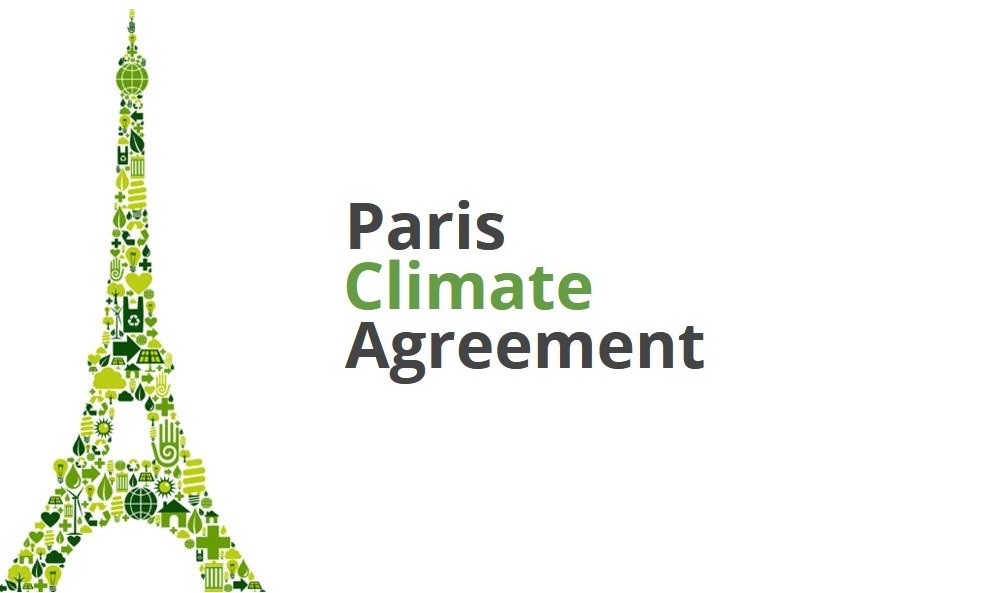Climate change represents one of the most daunting challenges on a global scale affecting the environment. Climate change which consists of a change in temperature, precipitation, and wind pattern, is primarily driven by the concentration of greenhouse gases in the atmosphere. Human activities such as the burning of fossils, deforestation and industrial processes are the major culprits of climate change.
This has continued to negatively impact the environment, resulting in floods, storms, droughts, and heat waves. The development of effective mechanisms to address climate change at the global level has remained elusive. Current international climate action under the Paris Agreement 2015 is hinged on the framework of nationally determined contributions (NDCs).
Employing textual analysis, this paper examined the prospects and pitfalls of the NDCs framework under the Paris Agreement. It focused on four critical areas: equity, common but differentiated responsibility, global peaking of greenhouse gas emissions, climate finance and transparency mechanisms.
The paper found that NDCs have several prospects for addressing climate change but that their lenient approach makes the framework unduly weak. It concluded that under the NDCs, the success of climate action would depend on the good intentions of the Parties.
The Paris Agreement is an instrument under the United Nations Framework Convention on Climate Change (UNFCCC).1 The Agreement was adopted in December 2015 by a decision of the 21st Conference of the Parties to the UNFCCC in Paris. It entered into force in November 2016 after meeting the dual condition for entry into force: ratification by 55 Parties representing 55% of global emitters of greenhouse gases (GHG).
The objectives of the Agreement are generally to limit the increase in the global average temperature to well below 2° C above pre-industrial levels, increase the ability to adapt and make finance flows consistent with a pathway towards low GHG emissions.3
A. Nationally Determined Contributions (NDCs)
Generally, NDCs are written statements of the efforts a Party intends to pursue towards tackling climate change.4 Article 4(2) of the Agreement provides:
Each Party shall prepare, communicate, and maintain successive nationally determined contributions that it intends to achieve. Parties shall pursue domestic mitigation measures, with the aim of achieving the objectives of such contributions.
For each Party, what the NDCs should contain are ‘nationally determined contributions that it intends to achieve,’ this simply means intentions determined at the national level. Although the Agreement does not provide specific contents of NDCs, it is evident that its contents will relate to the intended contributions of the Parties on the key aspects of climate action, like peaking, mitigation, adaptation, climate finance, and technology transfer.
It is because article 3 refers to NDCs as ambitious efforts as defined in articles 4, 7, 9, 10, 11 and 13. On each of these key aspects, Parties are to prepare their intended contributions.
B. NDCs: Prospects and Pitfalls
I. Equity, Common but Differentiated Responsibilities
The first and widely acknowledged prospect of NDCs is that it avoids the controversy of equitable imposition of climate obligations under the UNFCCC and the Kyoto Protocol. It is because since each Party is to nationally determine its contributions, equity and common but differentiated responsibility are left at the discretion of the Party.
This way, the controversy over equity is almost entirely eliminated. Meanwhile, within the same framework, developing country Parties are to take the lead, including providing finance to developing country Parties. The NDCs framework, therefore, cleverly tiptoes around one of the most contentious issues in international climate action.
The Agreement strives to make NDCs consistent with its objectives. First, there is a principle against backsliding or stagnation. Article 3 provides that the aggregate efforts of all Parties will represent a progression over time. For this reason, Article 4(3) requires individual successive NDCs to represent a progression.
After the preparation of the NDCs, the Party has an additional duty to maintain and communicate its NDCs. The communication of the NDCs is by filing a copy for recording with the Conference of the Parties at the Registry kept by the Secretariat. Successive NDCs are to be communicated every five years.
In communicating the NDCs, Parties are to supply information necessary for transparency, clarity and understanding of the NDCs. The communicated NDCs are kept in a public registry maintained by the Secretariat to allow for further public scrutiny. While a Party may at any time adjust its NDCs, it can only be with a view to enhancing its level of ambition. There is a further obligation on the Parties to account for their NDCs in accordance with guidance adopted by the Conference of the Parties.
This is a strong prospect both for levelling up and for accountability for NDCs. Nevertheless, allowing Parties to subjectively reflect equity and common but differentiated responsibility in their NDCs is not without setbacks. It is likely to negatively affect the level of ambitiousness of NDCs and even encourage free riding. The question of equity, upon which the doctrine of common but differentiated responsibility leans, has always been controversial in climate negotiations.
Shifting it to the Parties may underplay the controversy but serves to reduce ambitions. It is consistent with the findings of Tribett and others that for most developing country Parties, their NDCs are made conditional on the provision of climate finance. Considering the current global fossil fuel economy and market, Parties are tempted to unduly rely on respective national circumstances to communicate less ambitious NDCs.
Thus as Dong and others note, many of the NDCs are conservative.
II. Global Peaking of GHG Emissions
Article 4(1) of the Paris Agreement 2015 provides that to reach the temperature target under Article 2, Parties aim to reach global peaking in GHG emissions “as soon as possible” and then to undertake rapid reductions in emissions until there is a balance between anthropogenic emissions by sources and removal by sinks. It is illustrated in the diagram below:

Clearly, Article 4(1) is expressed as an ‘aim’ and does not necessarily translate into a binding obligation. However, by Article 3, such aim is an inherent part of NDCs. Parties are, therefore, to undertake ambitious efforts under Article 3 to meet this aim of global peaking stated in Article 4(1). What Article 4(1) envisages, as shown in the diagram, is a continuous an increase in emissions from the current level.
Such increase is arguably to allow for adaptations and developments until the increase reaches a peak. This is because Parties have the right to economic development, and there is a positive correlation between economic growth and an increase in carbon emissions, at least until non-fossil sources of energy have been well developed and deployed to become cost-effective. Thereafter, Parties are to undertake rapid reductions until a balance is reached between emissions by sources and removal by sinks.
Such balance is achieved when there is a stabilization of GHG concentrations at a level that prevents dangerous anthropogenic interference with the climate system. What the article labours to evolve is a system of climate action that prevents economic shock by allowing Parties to adjust naturally over time in accordance with their peculiar national circumstances. This is to ensure that food production is not threatened and to allow development to proceed in a sustainable manner.
Thus, peaking is still on the basis of equity and in the context of sustainable development and efforts to eradicate poverty. For this reason, it acknowledges that peaking may take longer for developing countries. This is consistent with the recital of the UNFCCC 1992, which notes that the global share in emissions from developing countries will grow to meet their developmental needs. However, upon closer interrogation, the liberal approach under Article 4(1) has several pitfalls which seriously undermine the temperature targets of the Agreement for the following reasons:
i. The Agreement does not define ‘global peaking’ of emissions or set a maximum level of emissions that Parties may reach under the global peaking window.
ii. There is no specific timeframe for Parties to reach global peaking except for the adjectival clauses ‘as soon as possible’ and ‘in the second half of this century’. The last year of this century will still be within the contemplation of the Agreement.
iii. To further complicate the timeframe, the article acknowledges that the peaking of global emissions will take longer for developing countries.
iv. There is no clear provision on what will amount to ‘rapid reductions’ in emissions after peaking. While it conveys a sharp progressive reduction, there is no template for its assessment on case-by-case bases.
v. Though all of these are to happen in the second half of the 21st century, there are no intermediate targets or aims at specified intervals towards the achievement of the long-term target. Very disappointingly, global peaking is stated as an ‘aim,’ not a binding obligation. Since Article 3 provides for NDCs as efforts defined inter alia in Article 4, it is beyond doubt that the specific provision of Article 4(1) overrides Article 3. Thus ‘aim’ must mean nothing less than ‘aim’. The second half of the 21st century is too fluid a timeline for effective climate action. And in the entire circumstances of climate change, arguably, outrageously long.
III. Climate Finance
It should be recalled that one of the sub-objectives of the Paris Agreement is to make the flow of finance consistent with a pathway towards low GHG emissions and climate-resilient development. It necessarily incorporates the flow of finance towards the pathway of the temperature goal of the Agreement.
Article 9 of the Agreement provides that developed country Parties shall provide financial resources to developing country Parties with regard to both mitigation and adaptation. This is in continuation of the already existing obligation under the UNFCCC 1992. For instance, under Article 4(3) of the Convention, developed country Parties have an obligation to provide new and additional finance to cover the full cost of compliance with Article 12(1) by developing country Parties.
Other Parties are encouraged to provide or continue to provide such support voluntarily. 25 Developed country Parties ‘should’ continue to take the lead in mobilizing climate finance. The mobilization is to represent a progression beyond previous efforts. Developed country Parties have a binding obligation to biennially communicate indicative quantitative and transparent information relating to the above. The information supplied shall also be considered at the global stock-take.
The financial mechanism under the Convention serves the financial mechanism under the Agreement.28 Under the Cancun Agreements of the COP, developed country Parties agree to jointly mobilize US $100 billion per year by 2020 to developing countries. This timeframe was increased to 2025 by the decision to adopt the Paris Agreement.
Under Article 100 of the Cancun Agreement, Parties decided that a significant share of the multilateral funding for mitigation would flow through the Green Fund established in Article 102. From the totality of the above, climate funding is a part of NDCs, although guided by the principles and specific obligations already highlighted and with regards to a minimum target amount. However, the approach has some setbacks. Whereas developing country Parties have a joint responsibility to contribute to the Fund, the absence of individual responsibility is disappointing. It follows that it is for each developed country Party to determine nationally what it intends to contribute to the fund. This will make it difficult to meet the financial goal.
Not surprising, therefore, the State Bank of India noted that the contributions made by Parties to the green climate fund (GCF) were only US$ 9.9 billion as at 19 May 2016. Similarly, Georges points out that the US in 2014 pledged 3 billion dollars but delivered only 1 billion and later abandoned the pledge.32 The framework is, therefore weak as there is no quantified commitment or clarity as to how finance will actually be raised.
B. Transparency Mechanism for Implementation of NDCs
Article 13(1) of the Paris Agreement 2015 established an enhanced transparency framework. The framework is in order to build mutual trust and confidence and to promote effective implementation of the Agreement. Equitable sharing of responsibilities in international climate action has always been controversial. This is further reinforced by the attractiveness of fossil fuels in the global economy. There is also the risk of free riding by other countries.
Climate action has, therefore, often been slow due to mutual suspicion and mutual distrust. It is against this background that the article seeks to build mutual trust and confidence in the implementation of the Agreement. This is even more important where the achievement of the objectives of the Agreement depends largely on Intended Nationally Determined Contributions.
Beyond doubt, mutual trust and confidence play a crucial role in the ambitiousness of both the NDCs and efforts of the Parties. The purpose of the transparency framework is to provide a clear understanding of climate action undertaken by the Parties in light of the objective of the Agreement. This will include clarity to enable tracking of progress in achieving respective NDCs.33 It extends to the clarity of support provided and received with regard to climate action under articles 4, 7, 9, 10 and 11.34 Put differently, the framework is to enable understanding of the NDCs under the different categories of climate action.
Article 13(7) creates a binding obligation on each Party to regularly provide the following information:
i. A national inventory report of anthropogenic emissions by sources and removals by sinks of greenhouse gases.
ii. Information necessary to track progress made in implementing and achieving its NDCs under Article 4.
The Agreement provides three layers of review of the NDCs for transparency:
i. Technical Expert Review under Article 13(11).
ii. The Parties shall participate in a facilitative, multilateral consideration of progress made.
iii. Global stock-take by the Conference of the Parties of the implementation of the Agreement under Article 14(1). The first global stock-take will take place in 2023 and thereafter every five years unless decided contrary to the Conference of the Parties.
Parties INDCs are then to take into account global stock-take.36 Savaresi writes that these mechanisms, when combined with the non-backsliding clause, ratchets up the level of ambition over time. The major pitfall of the framework is that it is to be implemented in a facilitative, non-intrusive and non-punitive manner.38 It is doubtful if such a lenient and loose approach will be effective.
It is because, as Sharma opines, it is easier for States to comply with international obligations when there is a system of reward and sanction. Also, if withdrawal from the commitment is costless and without consequences, it serves to further weaken the commitments. With regards to the Paris Agreement, he opines further that ‘the Agreement is remarkable for its leniency’.
Such leniency may be politically convenient for the Parties but adversely affects the achievement of the objectives of the Agreement. In the final analysis, whatever the review mechanism brings to bear on the Parties is a mere peer and public pressure. Though failure to meet NDCs may create for a Party what Fasoli calls ‘reputational risk’, the argument of this article remains that such reputational risks are an insufficient deterrent to compel compliance or even good faith in the light of climate politics.
Conclusion
The framework of NDCs allows for flexibility in both contributions and implementations in light of national circumstances. The system of NDCs also downplays the controversy of equitable differentiation of climate change responsibilities. It is facilitative, cooperative, and non-intrusive. It allows for gradual progression of efforts in a way that does not threaten national development. Besides, the NDCs are further boosted by the principles of the highest possible ambition and successive progression.
The above are very innovative provisions that make the NDCs including, their implementation and monitoring, promising. Thus, the Agreement represents a great prospect for tackling climate change. However, the leniency of the approach under NDCs raises concerns. There is a total absence of any specific Good intentions are not sufficient to engineer an effective i responsibility for any of the Parties. There is equally no sanction for breach of any of the obligations under the Agreement. Therefore, NDCs become practical statements of good intentions. ‘
Much will therefore depend on the good faith of the Parties. Yet, good faith and good intentions are not sufficient to engineer an effective international climate action




